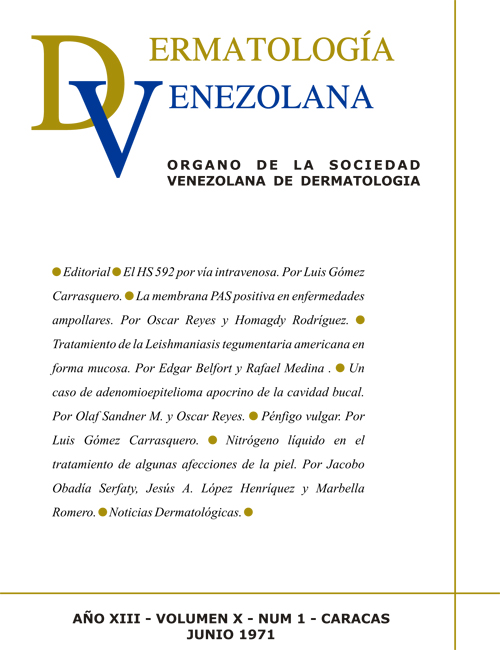LA MEMBRANA PAS POSITIVA EN ENFERMEDADES AMPOLLARES
Palabras clave:
MEMBRANA, PAS POSITIVA, ENFERMEDADES AMPOLLARESResumen
Se hace un breve análisis del significado y de la evolución de
los conceptos sobre la zona dermo-epidérmica. Se estudia el
comportamiento de la membrana PAS + en lupus eritematoso,
necrolisis tóxica epidérmica, porfiria cutánea tarda, eritema polimorfo,
liquen plano ampollar, enfermedad de Duhring y penfigoide ampollar.
Se hace un comentario a los hallazgos encontrados en el sentido de
estudiar detalles que pueden prestar utilidad a la característica
histoquímica de algunas afecciones y a su diagnóstico diferencial.
COMMENTS
Diseases which present liqueification of the basal stratum and
blistering diseases seem to be interesting affections for the study of
the pathology of the dermo-epidermic zone.
In this paper, where we study the behaviour of the PAS
membrane in several diseases, we have found some modifications,
apparently constant, for some of them; for instance, in lupus
erythematosus, the mebrane seems to stay always atached to the cells
of the basal stratum, except in one case, where the membrane drops to
the dermis and surrounds most of a great fibrinoid degeneration focus.
In lichen planus with blisters the membrane stay in the floor of the
blister, this may be an important fact in relation with the differential
diagnosis between this diseases and lupus erytematosus.
In two cases of dermal porphyria we saw a PAS + divided
membrane, parte of it was adhered to the epithelial ceiling of the
blister and the other to the dermal' floor. This finding was not seen in
any of the other diseases studied.
In the cases with Duhring disease, the membrane stays in the
floor of the blister, generaly thinned in some areas and even
interrupted. In two cases of Penphigoid blister no basal membrane was
seen. If
these findings are constant in these two diseases they would be
interesting for their differential diagnosis.
In two cases of Erythema polimorphus the PAS + membrane
atays adhered to the ceiling of the blister. Even though a larger
number of cases are needed, the behaviour of the PAS membrane
seems to be a histochemical charasteristic of some diseases useful for
their differential diagnosis.
SUMMARY
A short analysis of the significance and evolution of concepts
in relation with the dermo-epidermic zone is made. The behaviour of
the PAS + membrane is studied in lupus erythematosus, toxic
epidermal necrolysis, late dermal pophyria, blistering erythema
polimorphus, blistering lichen planus, Duhring's disease and
pemphigoid blisters.
Comments are made regarding the results in relation with the
need of studying the details that might characterize the histochemistry
of some diseases and thus facilitate differential diagnosis.
Descargas
Número
Sección
Licencia
Publicado por la Sociedad Venezolana de Dermatología Médica, Quirúrgica y Estética







